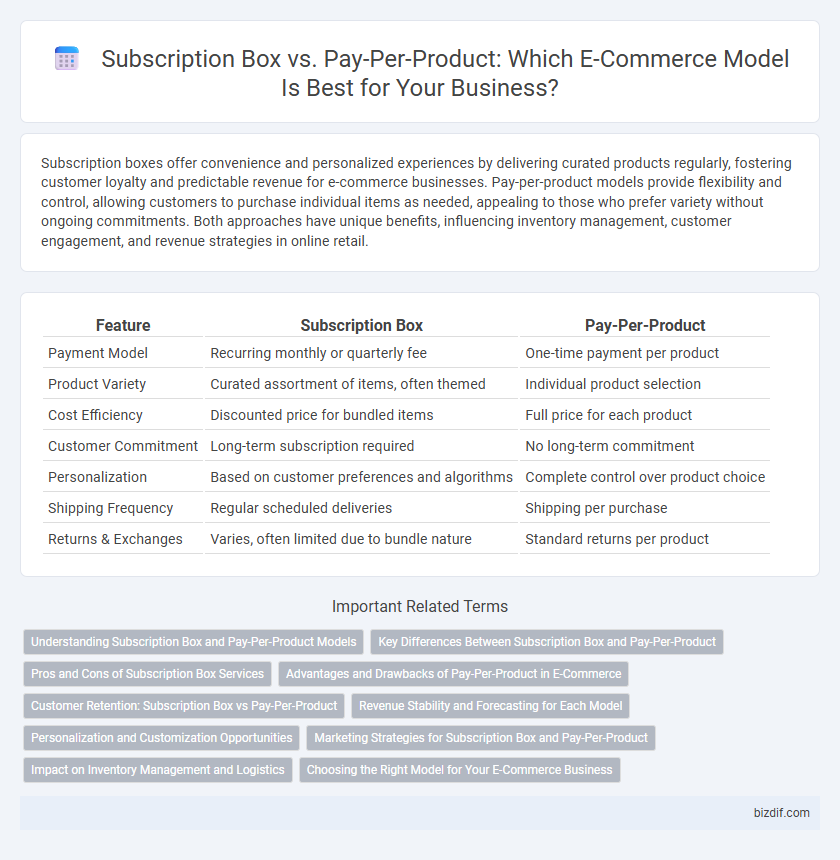Subscription boxes offer convenience and personalized experiences by delivering curated products regularly, fostering customer loyalty and predictable revenue for e-commerce businesses. Pay-per-product models provide flexibility and control, allowing customers to purchase individual items as needed, appealing to those who prefer variety without ongoing commitments. Both approaches have unique benefits, influencing inventory management, customer engagement, and revenue strategies in online retail.
Table of Comparison
| Feature | Subscription Box | Pay-Per-Product |
|---|---|---|
| Payment Model | Recurring monthly or quarterly fee | One-time payment per product |
| Product Variety | Curated assortment of items, often themed | Individual product selection |
| Cost Efficiency | Discounted price for bundled items | Full price for each product |
| Customer Commitment | Long-term subscription required | No long-term commitment |
| Personalization | Based on customer preferences and algorithms | Complete control over product choice |
| Shipping Frequency | Regular scheduled deliveries | Shipping per purchase |
| Returns & Exchanges | Varies, often limited due to bundle nature | Standard returns per product |
Understanding Subscription Box and Pay-Per-Product Models
The subscription box model offers customers curated products delivered regularly, providing convenience and a personalized shopping experience that drives customer loyalty and predictable revenue for e-commerce businesses. Pay-per-product allows consumers to purchase individual items on demand, offering flexibility and control without recurring commitments, appealing to buyers seeking variety or specific products. Both models leverage distinct customer behaviors and sales strategies, with subscription boxes emphasizing retention while pay-per-product focuses on immediate sales conversions.
Key Differences Between Subscription Box and Pay-Per-Product
Subscription boxes offer customers a recurring delivery of curated products, often at a discounted rate, creating convenience and a personalized experience. Pay-per-product models require customers to purchase individual items as needed, providing flexibility without ongoing commitments. Subscription boxes drive customer retention through predictable revenue and brand loyalty, whereas pay-per-product appeals to shoppers seeking one-time or varied purchases.
Pros and Cons of Subscription Box Services
Subscription box services offer consistent monthly revenue and enhance customer loyalty through curated, personalized product selections, fostering long-term brand engagement. However, they may lead to customer fatigue due to repetitive deliveries and can pose inventory management challenges, increasing operational complexity. Subscription models also face higher churn rates compared to pay-per-product sales, requiring ongoing efforts in customer retention and value proposition.
Advantages and Drawbacks of Pay-Per-Product in E-Commerce
Pay-per-product in e-commerce offers customers flexibility to purchase items individually without commitment, enhancing control over spending and reducing long-term financial risk. However, the model can lead to inconsistent revenue streams for businesses and may limit customer loyalty compared to subscription boxes, which encourage repeat engagement. Additionally, pay-per-product shoppers might experience less value perception and miss out on curated or discounted bundles commonly found in subscription services.
Customer Retention: Subscription Box vs Pay-Per-Product
Subscription box models enhance customer retention by providing consistent, personalized experiences that increase brand loyalty and lifetime value. Pay-per-product transactions may generate one-time sales but often lack the recurring engagement necessary for sustained customer relationships. E-commerce businesses leveraging subscription services benefit from predictable revenue streams and higher retention rates compared to pay-per-product sales.
Revenue Stability and Forecasting for Each Model
Subscription box models generate predictable monthly revenue by securing consistent customer commitment, enhancing cash flow stability and simplifying financial forecasting. In contrast, pay-per-product sales introduce revenue variability due to irregular purchase patterns, complicating demand forecasting and financial planning. Businesses leveraging subscription services benefit from more accurate long-term revenue projections compared to the fluctuating income typical of transactional e-commerce models.
Personalization and Customization Opportunities
Subscription boxes offer enhanced personalization by curating products based on individual preferences, purchase history, and behavior patterns, creating a tailored shopping experience that increases customer loyalty. Pay-per-product models allow for more precise customization by enabling customers to select specific items and features on a case-by-case basis, catering to unique needs without commitment to recurring deliveries. Both models leverage advanced algorithms and customer data to optimize personalization, but subscription boxes emphasize convenience and surprise, while pay-per-product focuses on control and specificity.
Marketing Strategies for Subscription Box and Pay-Per-Product
Subscription box marketing strategies emphasize personalized customer experiences and exclusive content to boost retention and lifetime value, leveraging data analytics for targeted promotions and cross-selling. Pay-per-product marketing focuses on highlighting product benefits and time-limited offers to drive immediate purchases, utilizing SEO and pay-per-click advertising to attract high-intent shoppers. Both models benefit from leveraging social proof and user-generated content to enhance trust and engagement across digital platforms.
Impact on Inventory Management and Logistics
Subscription box models enable businesses to predict inventory demand more accurately due to recurring orders, reducing stockouts and overstock risks. Pay-per-product sales require agile inventory management systems to handle fluctuating order volumes and diverse product preferences. Efficient logistics in subscription services often benefit from consolidated shipping, while pay-per-product demands flexible, often individualized shipping strategies.
Choosing the Right Model for Your E-Commerce Business
Choosing the right model for your e-commerce business involves evaluating customer preferences and cash flow stability. Subscription boxes provide predictable recurring revenue and higher customer lifetime value through curated experiences, while pay-per-product offers flexibility and lower commitment, attracting customers hesitant about long-term subscriptions. Analyze your target market's buying behavior and product type to optimize conversion rates and maximize profit margins.
Subscription Box vs Pay-Per-Product Infographic

 bizdif.com
bizdif.com